Genetics Problem Set: Detailed Questions and Answers
VerifiedAdded on 2023/06/05
|11
|2531
|113
Homework Assignment
AI Summary
This assignment provides detailed answers to a series of genetics questions, covering topics such as the ease of ligating sticky versus blunt ends, methylation in restriction sites, requirements for DNA ligation, the value of phosphatase, and the purpose of removing phosphatase before using DNA ligase. It further explains TA and TOPO cloning techniques, discusses the advantages of TA- and TOPO-cloning over restriction fragments, and analyzes the behavior of different plasmid forms in agarose gel electrophoresis. The assignment also defines key concepts like vectors, gene libraries, and complementation, while also exploring the significance of p-values in library creation, advantages of using partially digested DNA, and the roles of tra proteins. It concludes by elaborating on the utility of transposons and the concept of a genetic footprint, offering a comprehensive overview of essential genetics principles. Desklib offers a wide array of similar solved assignments and past papers to aid students in their studies.

Running head: QUESTIONS ON GENETICS 1
Questions on Genetic
Name
Institution
Course
Date
Questions on Genetic
Name
Institution
Course
Date
Paraphrase This Document
Need a fresh take? Get an instant paraphrase of this document with our AI Paraphraser
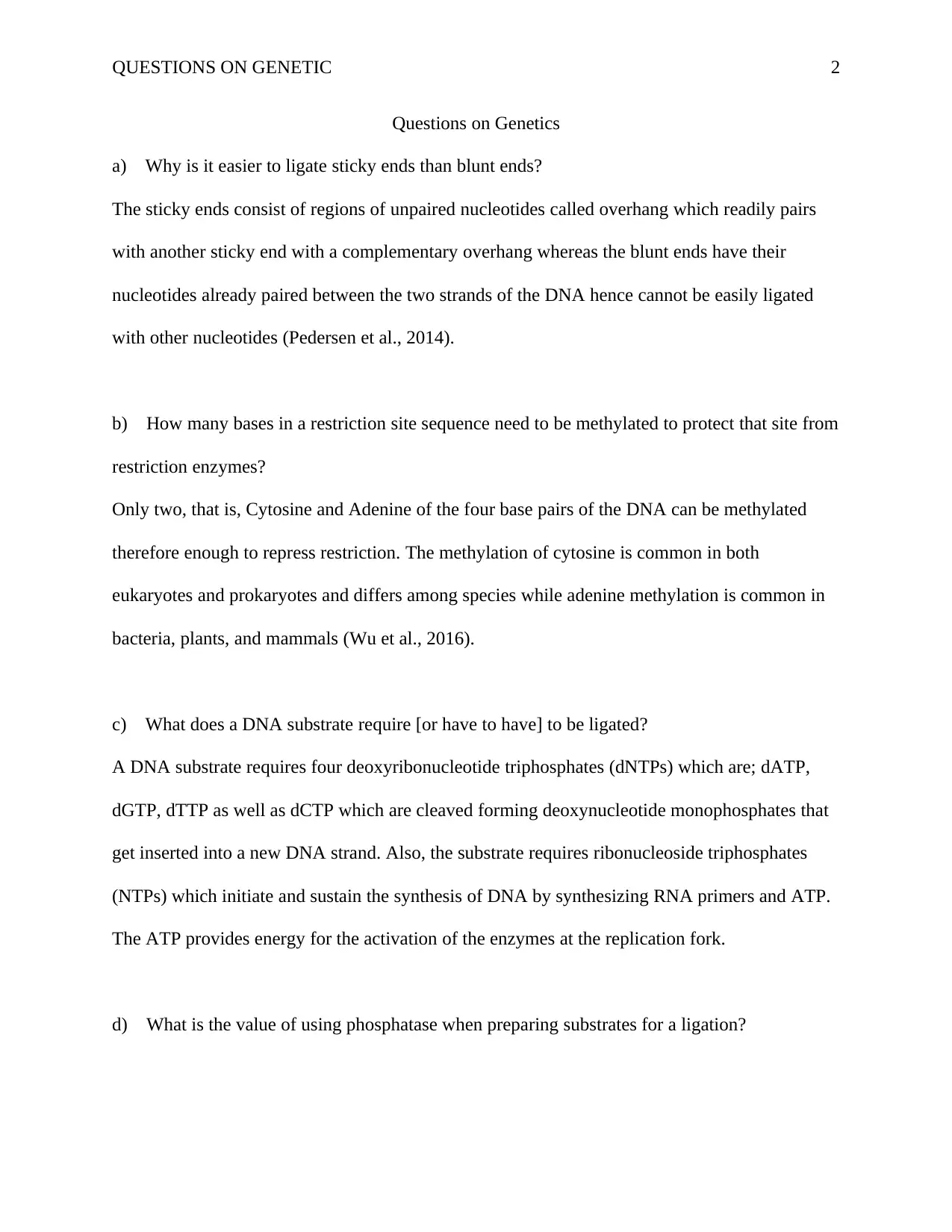
QUESTIONS ON GENETIC 2
Questions on Genetics
a) Why is it easier to ligate sticky ends than blunt ends?
The sticky ends consist of regions of unpaired nucleotides called overhang which readily pairs
with another sticky end with a complementary overhang whereas the blunt ends have their
nucleotides already paired between the two strands of the DNA hence cannot be easily ligated
with other nucleotides (Pedersen et al., 2014).
b) How many bases in a restriction site sequence need to be methylated to protect that site from
restriction enzymes?
Only two, that is, Cytosine and Adenine of the four base pairs of the DNA can be methylated
therefore enough to repress restriction. The methylation of cytosine is common in both
eukaryotes and prokaryotes and differs among species while adenine methylation is common in
bacteria, plants, and mammals (Wu et al., 2016).
c) What does a DNA substrate require [or have to have] to be ligated?
A DNA substrate requires four deoxyribonucleotide triphosphates (dNTPs) which are; dATP,
dGTP, dTTP as well as dCTP which are cleaved forming deoxynucleotide monophosphates that
get inserted into a new DNA strand. Also, the substrate requires ribonucleoside triphosphates
(NTPs) which initiate and sustain the synthesis of DNA by synthesizing RNA primers and ATP.
The ATP provides energy for the activation of the enzymes at the replication fork.
d) What is the value of using phosphatase when preparing substrates for a ligation?
Questions on Genetics
a) Why is it easier to ligate sticky ends than blunt ends?
The sticky ends consist of regions of unpaired nucleotides called overhang which readily pairs
with another sticky end with a complementary overhang whereas the blunt ends have their
nucleotides already paired between the two strands of the DNA hence cannot be easily ligated
with other nucleotides (Pedersen et al., 2014).
b) How many bases in a restriction site sequence need to be methylated to protect that site from
restriction enzymes?
Only two, that is, Cytosine and Adenine of the four base pairs of the DNA can be methylated
therefore enough to repress restriction. The methylation of cytosine is common in both
eukaryotes and prokaryotes and differs among species while adenine methylation is common in
bacteria, plants, and mammals (Wu et al., 2016).
c) What does a DNA substrate require [or have to have] to be ligated?
A DNA substrate requires four deoxyribonucleotide triphosphates (dNTPs) which are; dATP,
dGTP, dTTP as well as dCTP which are cleaved forming deoxynucleotide monophosphates that
get inserted into a new DNA strand. Also, the substrate requires ribonucleoside triphosphates
(NTPs) which initiate and sustain the synthesis of DNA by synthesizing RNA primers and ATP.
The ATP provides energy for the activation of the enzymes at the replication fork.
d) What is the value of using phosphatase when preparing substrates for a ligation?
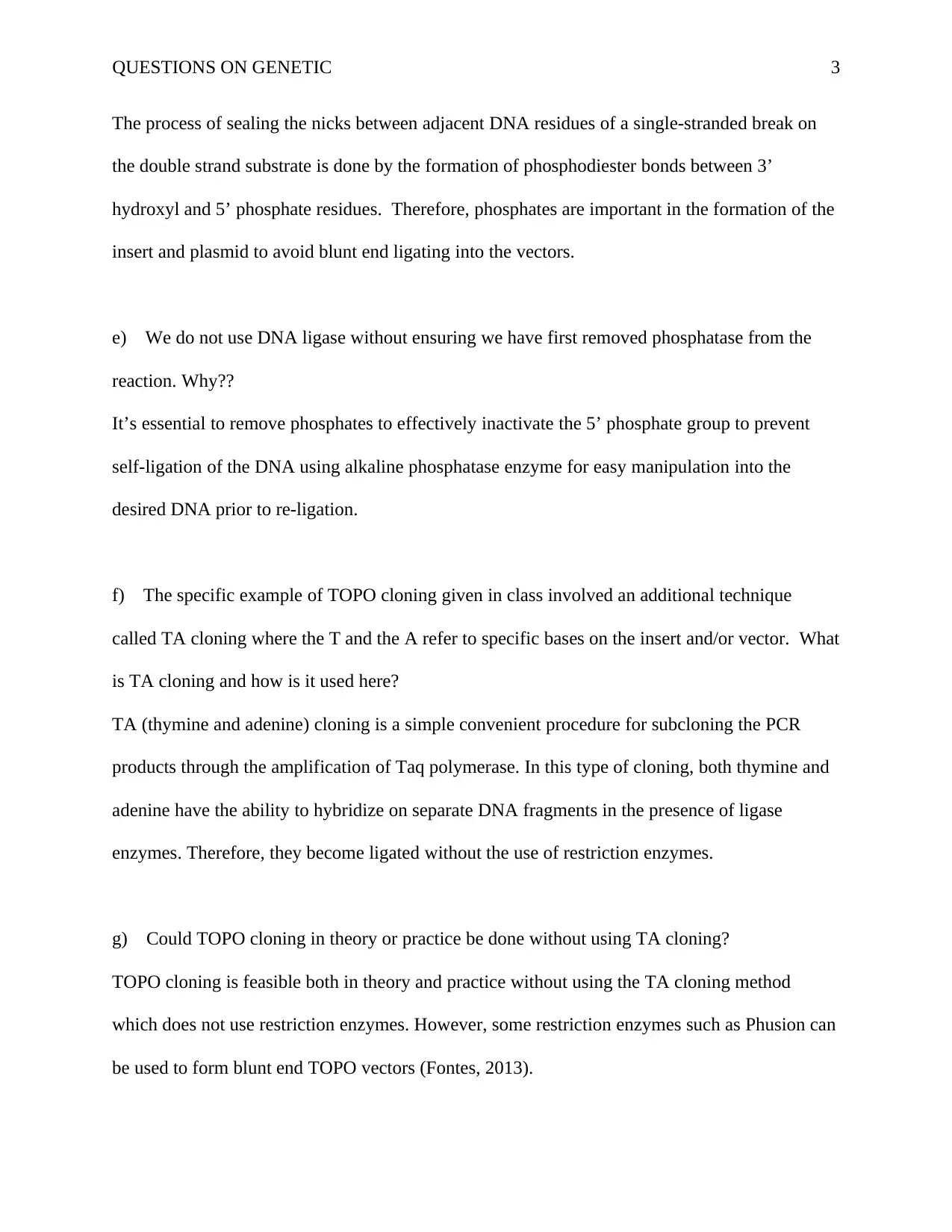
QUESTIONS ON GENETIC 3
The process of sealing the nicks between adjacent DNA residues of a single-stranded break on
the double strand substrate is done by the formation of phosphodiester bonds between 3’
hydroxyl and 5’ phosphate residues. Therefore, phosphates are important in the formation of the
insert and plasmid to avoid blunt end ligating into the vectors.
e) We do not use DNA ligase without ensuring we have first removed phosphatase from the
reaction. Why??
It’s essential to remove phosphates to effectively inactivate the 5’ phosphate group to prevent
self-ligation of the DNA using alkaline phosphatase enzyme for easy manipulation into the
desired DNA prior to re-ligation.
f) The specific example of TOPO cloning given in class involved an additional technique
called TA cloning where the T and the A refer to specific bases on the insert and/or vector. What
is TA cloning and how is it used here?
TA (thymine and adenine) cloning is a simple convenient procedure for subcloning the PCR
products through the amplification of Taq polymerase. In this type of cloning, both thymine and
adenine have the ability to hybridize on separate DNA fragments in the presence of ligase
enzymes. Therefore, they become ligated without the use of restriction enzymes.
g) Could TOPO cloning in theory or practice be done without using TA cloning?
TOPO cloning is feasible both in theory and practice without using the TA cloning method
which does not use restriction enzymes. However, some restriction enzymes such as Phusion can
be used to form blunt end TOPO vectors (Fontes, 2013).
The process of sealing the nicks between adjacent DNA residues of a single-stranded break on
the double strand substrate is done by the formation of phosphodiester bonds between 3’
hydroxyl and 5’ phosphate residues. Therefore, phosphates are important in the formation of the
insert and plasmid to avoid blunt end ligating into the vectors.
e) We do not use DNA ligase without ensuring we have first removed phosphatase from the
reaction. Why??
It’s essential to remove phosphates to effectively inactivate the 5’ phosphate group to prevent
self-ligation of the DNA using alkaline phosphatase enzyme for easy manipulation into the
desired DNA prior to re-ligation.
f) The specific example of TOPO cloning given in class involved an additional technique
called TA cloning where the T and the A refer to specific bases on the insert and/or vector. What
is TA cloning and how is it used here?
TA (thymine and adenine) cloning is a simple convenient procedure for subcloning the PCR
products through the amplification of Taq polymerase. In this type of cloning, both thymine and
adenine have the ability to hybridize on separate DNA fragments in the presence of ligase
enzymes. Therefore, they become ligated without the use of restriction enzymes.
g) Could TOPO cloning in theory or practice be done without using TA cloning?
TOPO cloning is feasible both in theory and practice without using the TA cloning method
which does not use restriction enzymes. However, some restriction enzymes such as Phusion can
be used to form blunt end TOPO vectors (Fontes, 2013).
⊘ This is a preview!⊘
Do you want full access?
Subscribe today to unlock all pages.

Trusted by 1+ million students worldwide
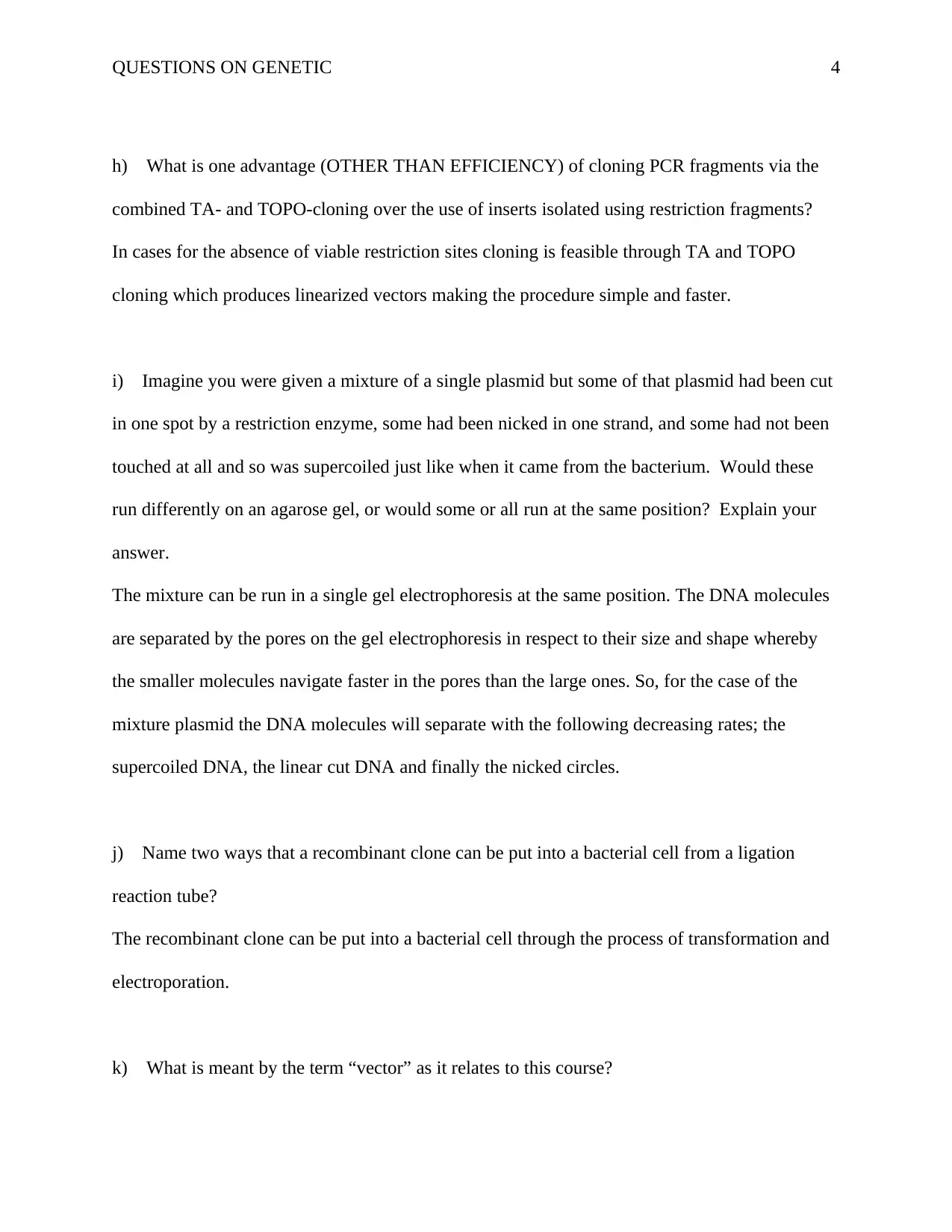
QUESTIONS ON GENETIC 4
h) What is one advantage (OTHER THAN EFFICIENCY) of cloning PCR fragments via the
combined TA- and TOPO-cloning over the use of inserts isolated using restriction fragments?
In cases for the absence of viable restriction sites cloning is feasible through TA and TOPO
cloning which produces linearized vectors making the procedure simple and faster.
i) Imagine you were given a mixture of a single plasmid but some of that plasmid had been cut
in one spot by a restriction enzyme, some had been nicked in one strand, and some had not been
touched at all and so was supercoiled just like when it came from the bacterium. Would these
run differently on an agarose gel, or would some or all run at the same position? Explain your
answer.
The mixture can be run in a single gel electrophoresis at the same position. The DNA molecules
are separated by the pores on the gel electrophoresis in respect to their size and shape whereby
the smaller molecules navigate faster in the pores than the large ones. So, for the case of the
mixture plasmid the DNA molecules will separate with the following decreasing rates; the
supercoiled DNA, the linear cut DNA and finally the nicked circles.
j) Name two ways that a recombinant clone can be put into a bacterial cell from a ligation
reaction tube?
The recombinant clone can be put into a bacterial cell through the process of transformation and
electroporation.
k) What is meant by the term “vector” as it relates to this course?
h) What is one advantage (OTHER THAN EFFICIENCY) of cloning PCR fragments via the
combined TA- and TOPO-cloning over the use of inserts isolated using restriction fragments?
In cases for the absence of viable restriction sites cloning is feasible through TA and TOPO
cloning which produces linearized vectors making the procedure simple and faster.
i) Imagine you were given a mixture of a single plasmid but some of that plasmid had been cut
in one spot by a restriction enzyme, some had been nicked in one strand, and some had not been
touched at all and so was supercoiled just like when it came from the bacterium. Would these
run differently on an agarose gel, or would some or all run at the same position? Explain your
answer.
The mixture can be run in a single gel electrophoresis at the same position. The DNA molecules
are separated by the pores on the gel electrophoresis in respect to their size and shape whereby
the smaller molecules navigate faster in the pores than the large ones. So, for the case of the
mixture plasmid the DNA molecules will separate with the following decreasing rates; the
supercoiled DNA, the linear cut DNA and finally the nicked circles.
j) Name two ways that a recombinant clone can be put into a bacterial cell from a ligation
reaction tube?
The recombinant clone can be put into a bacterial cell through the process of transformation and
electroporation.
k) What is meant by the term “vector” as it relates to this course?
Paraphrase This Document
Need a fresh take? Get an instant paraphrase of this document with our AI Paraphraser
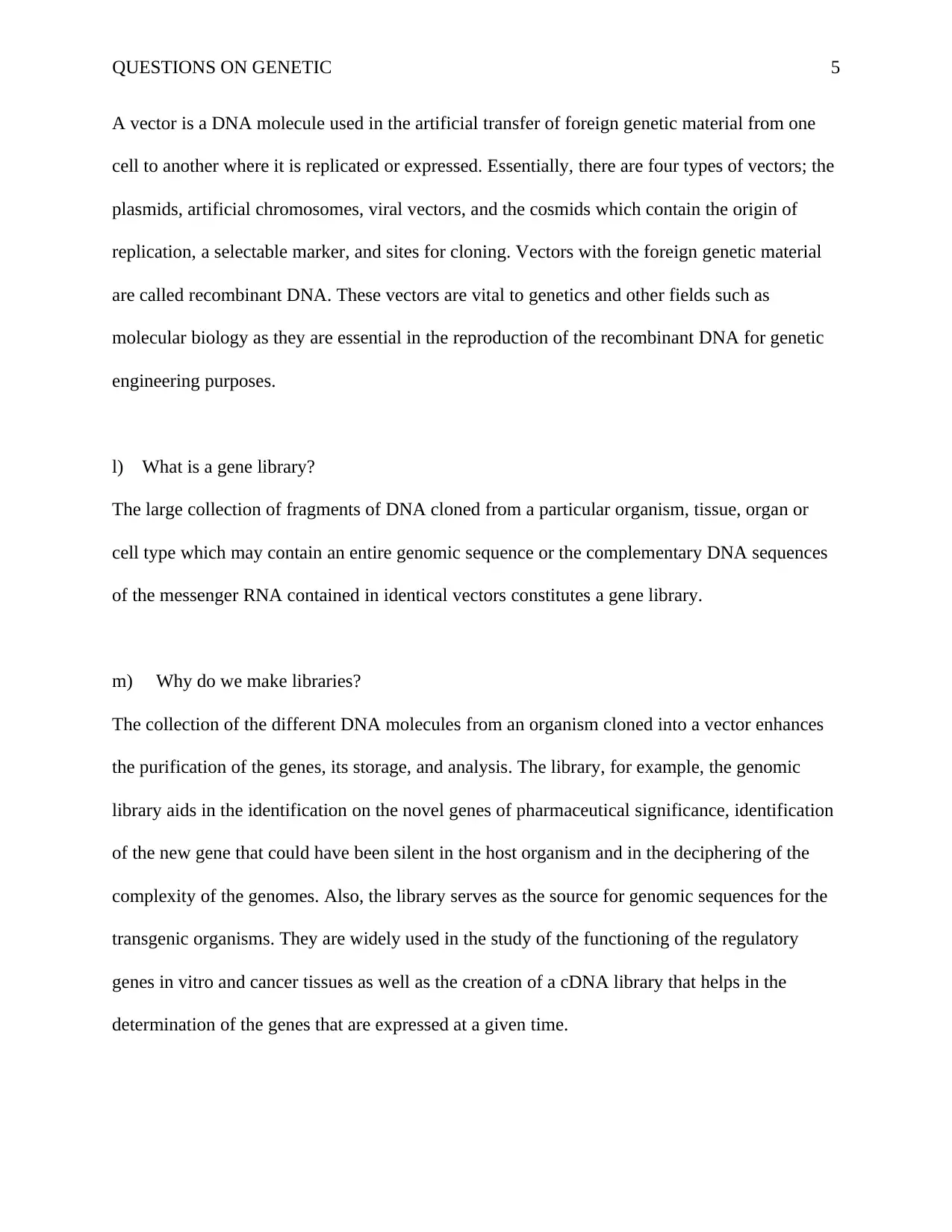
QUESTIONS ON GENETIC 5
A vector is a DNA molecule used in the artificial transfer of foreign genetic material from one
cell to another where it is replicated or expressed. Essentially, there are four types of vectors; the
plasmids, artificial chromosomes, viral vectors, and the cosmids which contain the origin of
replication, a selectable marker, and sites for cloning. Vectors with the foreign genetic material
are called recombinant DNA. These vectors are vital to genetics and other fields such as
molecular biology as they are essential in the reproduction of the recombinant DNA for genetic
engineering purposes.
l) What is a gene library?
The large collection of fragments of DNA cloned from a particular organism, tissue, organ or
cell type which may contain an entire genomic sequence or the complementary DNA sequences
of the messenger RNA contained in identical vectors constitutes a gene library.
m) Why do we make libraries?
The collection of the different DNA molecules from an organism cloned into a vector enhances
the purification of the genes, its storage, and analysis. The library, for example, the genomic
library aids in the identification on the novel genes of pharmaceutical significance, identification
of the new gene that could have been silent in the host organism and in the deciphering of the
complexity of the genomes. Also, the library serves as the source for genomic sequences for the
transgenic organisms. They are widely used in the study of the functioning of the regulatory
genes in vitro and cancer tissues as well as the creation of a cDNA library that helps in the
determination of the genes that are expressed at a given time.
A vector is a DNA molecule used in the artificial transfer of foreign genetic material from one
cell to another where it is replicated or expressed. Essentially, there are four types of vectors; the
plasmids, artificial chromosomes, viral vectors, and the cosmids which contain the origin of
replication, a selectable marker, and sites for cloning. Vectors with the foreign genetic material
are called recombinant DNA. These vectors are vital to genetics and other fields such as
molecular biology as they are essential in the reproduction of the recombinant DNA for genetic
engineering purposes.
l) What is a gene library?
The large collection of fragments of DNA cloned from a particular organism, tissue, organ or
cell type which may contain an entire genomic sequence or the complementary DNA sequences
of the messenger RNA contained in identical vectors constitutes a gene library.
m) Why do we make libraries?
The collection of the different DNA molecules from an organism cloned into a vector enhances
the purification of the genes, its storage, and analysis. The library, for example, the genomic
library aids in the identification on the novel genes of pharmaceutical significance, identification
of the new gene that could have been silent in the host organism and in the deciphering of the
complexity of the genomes. Also, the library serves as the source for genomic sequences for the
transgenic organisms. They are widely used in the study of the functioning of the regulatory
genes in vitro and cancer tissues as well as the creation of a cDNA library that helps in the
determination of the genes that are expressed at a given time.
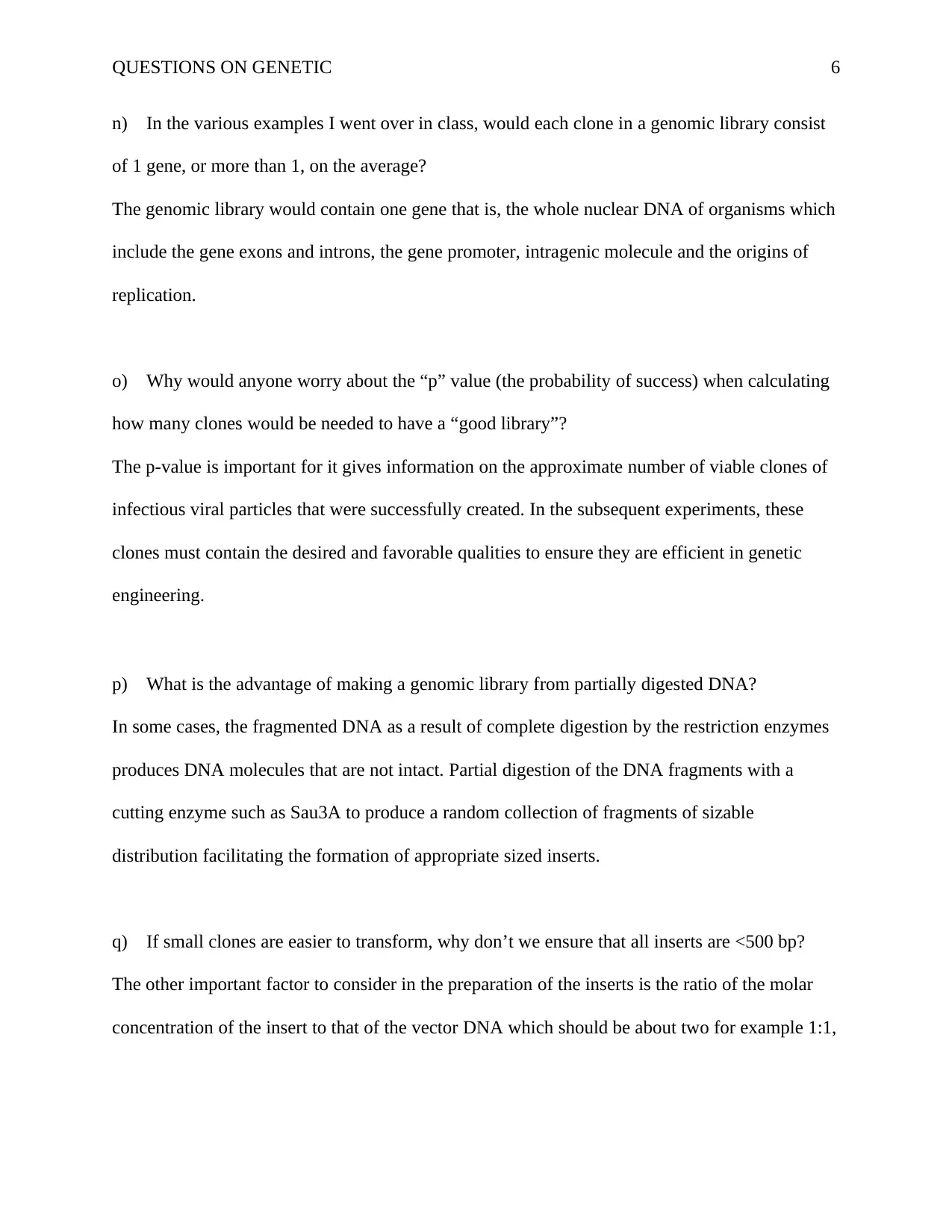
QUESTIONS ON GENETIC 6
n) In the various examples I went over in class, would each clone in a genomic library consist
of 1 gene, or more than 1, on the average?
The genomic library would contain one gene that is, the whole nuclear DNA of organisms which
include the gene exons and introns, the gene promoter, intragenic molecule and the origins of
replication.
o) Why would anyone worry about the “p” value (the probability of success) when calculating
how many clones would be needed to have a “good library”?
The p-value is important for it gives information on the approximate number of viable clones of
infectious viral particles that were successfully created. In the subsequent experiments, these
clones must contain the desired and favorable qualities to ensure they are efficient in genetic
engineering.
p) What is the advantage of making a genomic library from partially digested DNA?
In some cases, the fragmented DNA as a result of complete digestion by the restriction enzymes
produces DNA molecules that are not intact. Partial digestion of the DNA fragments with a
cutting enzyme such as Sau3A to produce a random collection of fragments of sizable
distribution facilitating the formation of appropriate sized inserts.
q) If small clones are easier to transform, why don’t we ensure that all inserts are <500 bp?
The other important factor to consider in the preparation of the inserts is the ratio of the molar
concentration of the insert to that of the vector DNA which should be about two for example 1:1,
n) In the various examples I went over in class, would each clone in a genomic library consist
of 1 gene, or more than 1, on the average?
The genomic library would contain one gene that is, the whole nuclear DNA of organisms which
include the gene exons and introns, the gene promoter, intragenic molecule and the origins of
replication.
o) Why would anyone worry about the “p” value (the probability of success) when calculating
how many clones would be needed to have a “good library”?
The p-value is important for it gives information on the approximate number of viable clones of
infectious viral particles that were successfully created. In the subsequent experiments, these
clones must contain the desired and favorable qualities to ensure they are efficient in genetic
engineering.
p) What is the advantage of making a genomic library from partially digested DNA?
In some cases, the fragmented DNA as a result of complete digestion by the restriction enzymes
produces DNA molecules that are not intact. Partial digestion of the DNA fragments with a
cutting enzyme such as Sau3A to produce a random collection of fragments of sizable
distribution facilitating the formation of appropriate sized inserts.
q) If small clones are easier to transform, why don’t we ensure that all inserts are <500 bp?
The other important factor to consider in the preparation of the inserts is the ratio of the molar
concentration of the insert to that of the vector DNA which should be about two for example 1:1,
⊘ This is a preview!⊘
Do you want full access?
Subscribe today to unlock all pages.

Trusted by 1+ million students worldwide
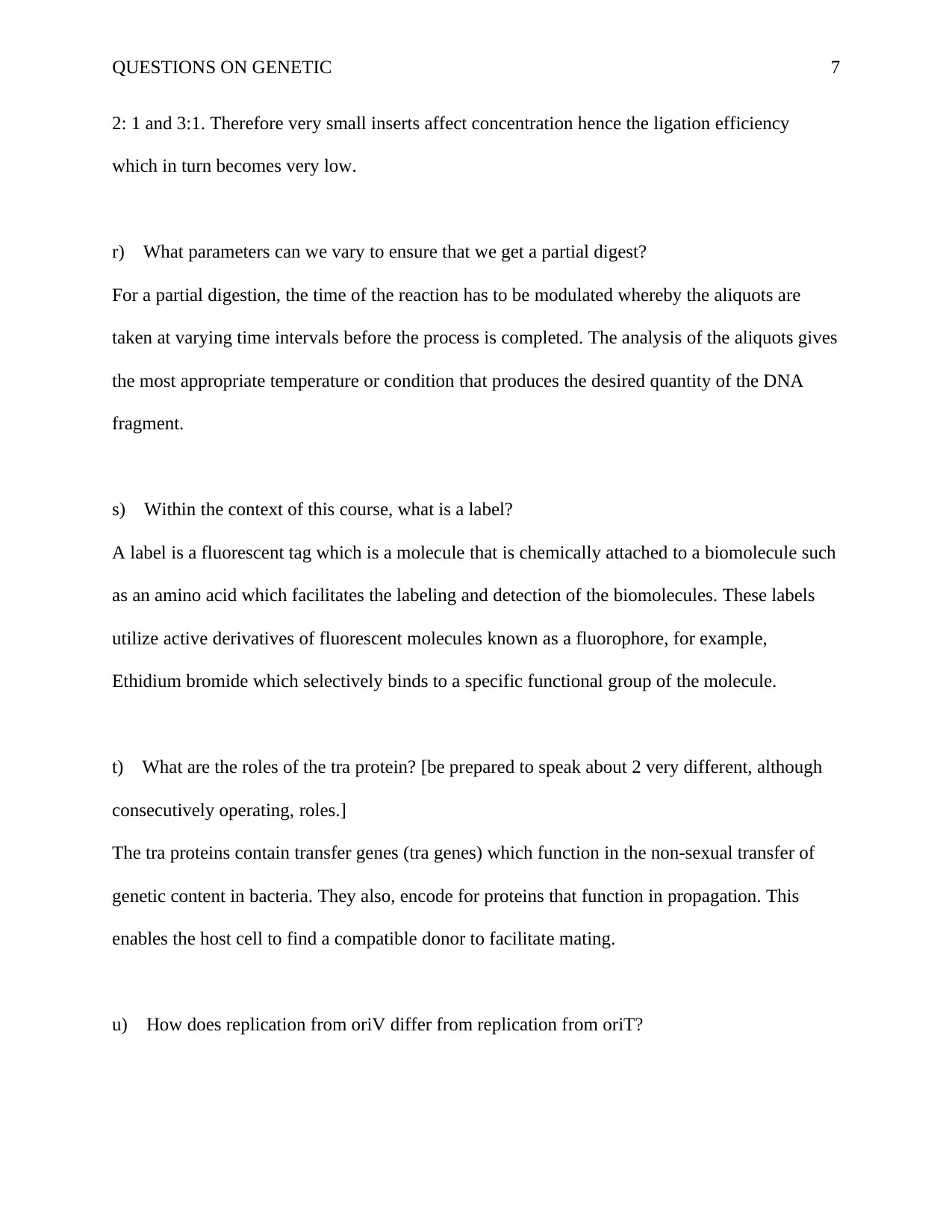
QUESTIONS ON GENETIC 7
2: 1 and 3:1. Therefore very small inserts affect concentration hence the ligation efficiency
which in turn becomes very low.
r) What parameters can we vary to ensure that we get a partial digest?
For a partial digestion, the time of the reaction has to be modulated whereby the aliquots are
taken at varying time intervals before the process is completed. The analysis of the aliquots gives
the most appropriate temperature or condition that produces the desired quantity of the DNA
fragment.
s) Within the context of this course, what is a label?
A label is a fluorescent tag which is a molecule that is chemically attached to a biomolecule such
as an amino acid which facilitates the labeling and detection of the biomolecules. These labels
utilize active derivatives of fluorescent molecules known as a fluorophore, for example,
Ethidium bromide which selectively binds to a specific functional group of the molecule.
t) What are the roles of the tra protein? [be prepared to speak about 2 very different, although
consecutively operating, roles.]
The tra proteins contain transfer genes (tra genes) which function in the non-sexual transfer of
genetic content in bacteria. They also, encode for proteins that function in propagation. This
enables the host cell to find a compatible donor to facilitate mating.
u) How does replication from oriV differ from replication from oriT?
2: 1 and 3:1. Therefore very small inserts affect concentration hence the ligation efficiency
which in turn becomes very low.
r) What parameters can we vary to ensure that we get a partial digest?
For a partial digestion, the time of the reaction has to be modulated whereby the aliquots are
taken at varying time intervals before the process is completed. The analysis of the aliquots gives
the most appropriate temperature or condition that produces the desired quantity of the DNA
fragment.
s) Within the context of this course, what is a label?
A label is a fluorescent tag which is a molecule that is chemically attached to a biomolecule such
as an amino acid which facilitates the labeling and detection of the biomolecules. These labels
utilize active derivatives of fluorescent molecules known as a fluorophore, for example,
Ethidium bromide which selectively binds to a specific functional group of the molecule.
t) What are the roles of the tra protein? [be prepared to speak about 2 very different, although
consecutively operating, roles.]
The tra proteins contain transfer genes (tra genes) which function in the non-sexual transfer of
genetic content in bacteria. They also, encode for proteins that function in propagation. This
enables the host cell to find a compatible donor to facilitate mating.
u) How does replication from oriV differ from replication from oriT?
Paraphrase This Document
Need a fresh take? Get an instant paraphrase of this document with our AI Paraphraser
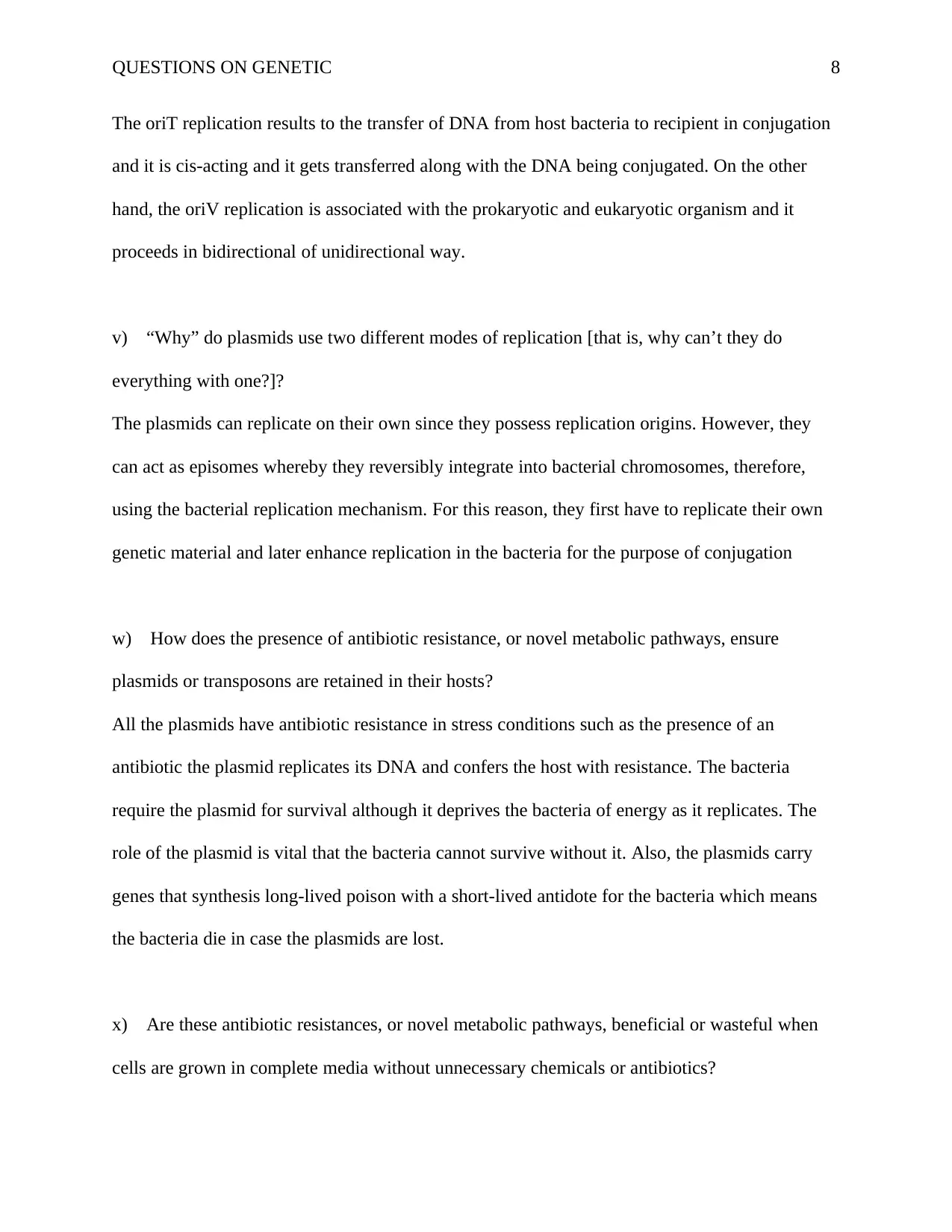
QUESTIONS ON GENETIC 8
The oriT replication results to the transfer of DNA from host bacteria to recipient in conjugation
and it is cis-acting and it gets transferred along with the DNA being conjugated. On the other
hand, the oriV replication is associated with the prokaryotic and eukaryotic organism and it
proceeds in bidirectional of unidirectional way.
v) “Why” do plasmids use two different modes of replication [that is, why can’t they do
everything with one?]?
The plasmids can replicate on their own since they possess replication origins. However, they
can act as episomes whereby they reversibly integrate into bacterial chromosomes, therefore,
using the bacterial replication mechanism. For this reason, they first have to replicate their own
genetic material and later enhance replication in the bacteria for the purpose of conjugation
w) How does the presence of antibiotic resistance, or novel metabolic pathways, ensure
plasmids or transposons are retained in their hosts?
All the plasmids have antibiotic resistance in stress conditions such as the presence of an
antibiotic the plasmid replicates its DNA and confers the host with resistance. The bacteria
require the plasmid for survival although it deprives the bacteria of energy as it replicates. The
role of the plasmid is vital that the bacteria cannot survive without it. Also, the plasmids carry
genes that synthesis long-lived poison with a short-lived antidote for the bacteria which means
the bacteria die in case the plasmids are lost.
x) Are these antibiotic resistances, or novel metabolic pathways, beneficial or wasteful when
cells are grown in complete media without unnecessary chemicals or antibiotics?
The oriT replication results to the transfer of DNA from host bacteria to recipient in conjugation
and it is cis-acting and it gets transferred along with the DNA being conjugated. On the other
hand, the oriV replication is associated with the prokaryotic and eukaryotic organism and it
proceeds in bidirectional of unidirectional way.
v) “Why” do plasmids use two different modes of replication [that is, why can’t they do
everything with one?]?
The plasmids can replicate on their own since they possess replication origins. However, they
can act as episomes whereby they reversibly integrate into bacterial chromosomes, therefore,
using the bacterial replication mechanism. For this reason, they first have to replicate their own
genetic material and later enhance replication in the bacteria for the purpose of conjugation
w) How does the presence of antibiotic resistance, or novel metabolic pathways, ensure
plasmids or transposons are retained in their hosts?
All the plasmids have antibiotic resistance in stress conditions such as the presence of an
antibiotic the plasmid replicates its DNA and confers the host with resistance. The bacteria
require the plasmid for survival although it deprives the bacteria of energy as it replicates. The
role of the plasmid is vital that the bacteria cannot survive without it. Also, the plasmids carry
genes that synthesis long-lived poison with a short-lived antidote for the bacteria which means
the bacteria die in case the plasmids are lost.
x) Are these antibiotic resistances, or novel metabolic pathways, beneficial or wasteful when
cells are grown in complete media without unnecessary chemicals or antibiotics?
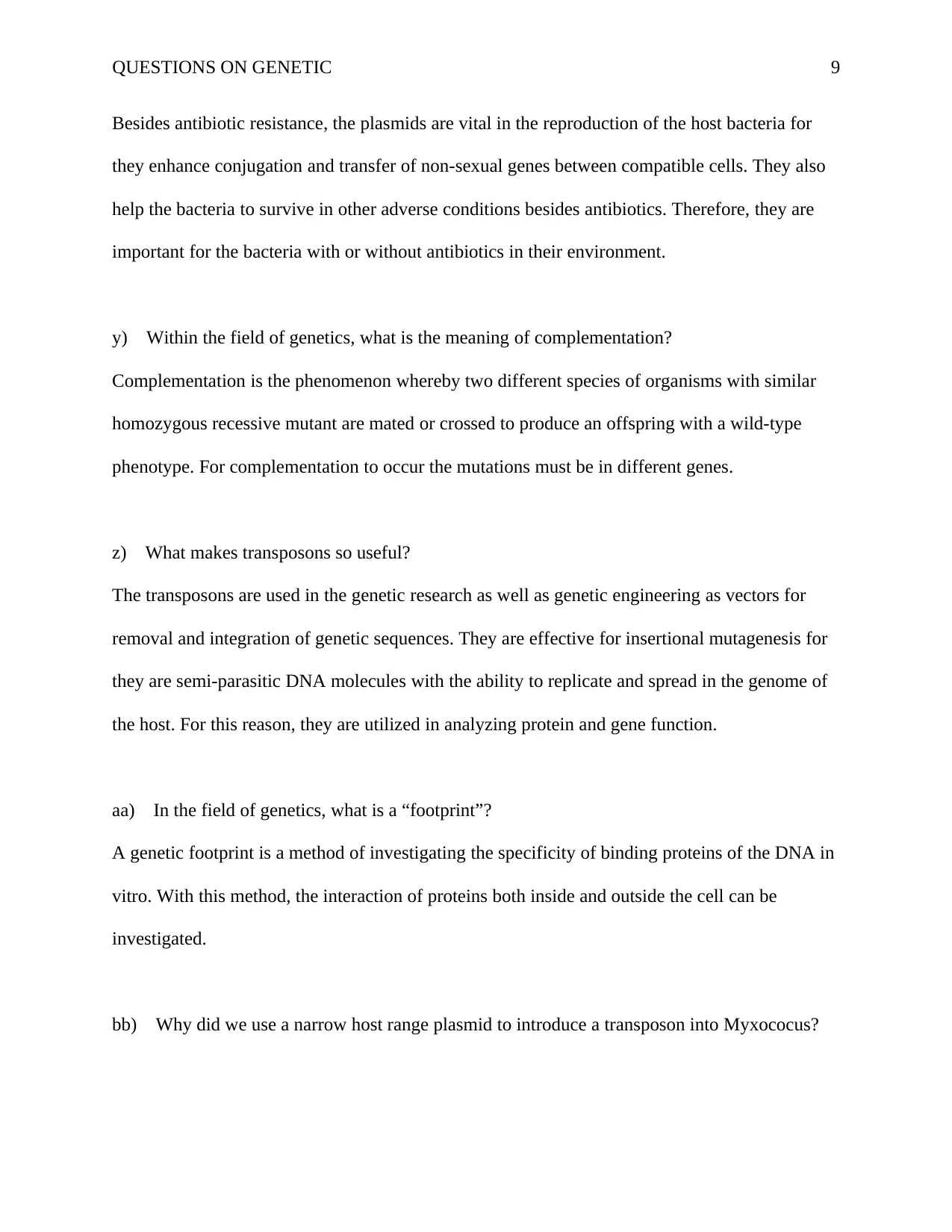
QUESTIONS ON GENETIC 9
Besides antibiotic resistance, the plasmids are vital in the reproduction of the host bacteria for
they enhance conjugation and transfer of non-sexual genes between compatible cells. They also
help the bacteria to survive in other adverse conditions besides antibiotics. Therefore, they are
important for the bacteria with or without antibiotics in their environment.
y) Within the field of genetics, what is the meaning of complementation?
Complementation is the phenomenon whereby two different species of organisms with similar
homozygous recessive mutant are mated or crossed to produce an offspring with a wild-type
phenotype. For complementation to occur the mutations must be in different genes.
z) What makes transposons so useful?
The transposons are used in the genetic research as well as genetic engineering as vectors for
removal and integration of genetic sequences. They are effective for insertional mutagenesis for
they are semi-parasitic DNA molecules with the ability to replicate and spread in the genome of
the host. For this reason, they are utilized in analyzing protein and gene function.
aa) In the field of genetics, what is a “footprint”?
A genetic footprint is a method of investigating the specificity of binding proteins of the DNA in
vitro. With this method, the interaction of proteins both inside and outside the cell can be
investigated.
bb) Why did we use a narrow host range plasmid to introduce a transposon into Myxococus?
Besides antibiotic resistance, the plasmids are vital in the reproduction of the host bacteria for
they enhance conjugation and transfer of non-sexual genes between compatible cells. They also
help the bacteria to survive in other adverse conditions besides antibiotics. Therefore, they are
important for the bacteria with or without antibiotics in their environment.
y) Within the field of genetics, what is the meaning of complementation?
Complementation is the phenomenon whereby two different species of organisms with similar
homozygous recessive mutant are mated or crossed to produce an offspring with a wild-type
phenotype. For complementation to occur the mutations must be in different genes.
z) What makes transposons so useful?
The transposons are used in the genetic research as well as genetic engineering as vectors for
removal and integration of genetic sequences. They are effective for insertional mutagenesis for
they are semi-parasitic DNA molecules with the ability to replicate and spread in the genome of
the host. For this reason, they are utilized in analyzing protein and gene function.
aa) In the field of genetics, what is a “footprint”?
A genetic footprint is a method of investigating the specificity of binding proteins of the DNA in
vitro. With this method, the interaction of proteins both inside and outside the cell can be
investigated.
bb) Why did we use a narrow host range plasmid to introduce a transposon into Myxococus?
⊘ This is a preview!⊘
Do you want full access?
Subscribe today to unlock all pages.

Trusted by 1+ million students worldwide
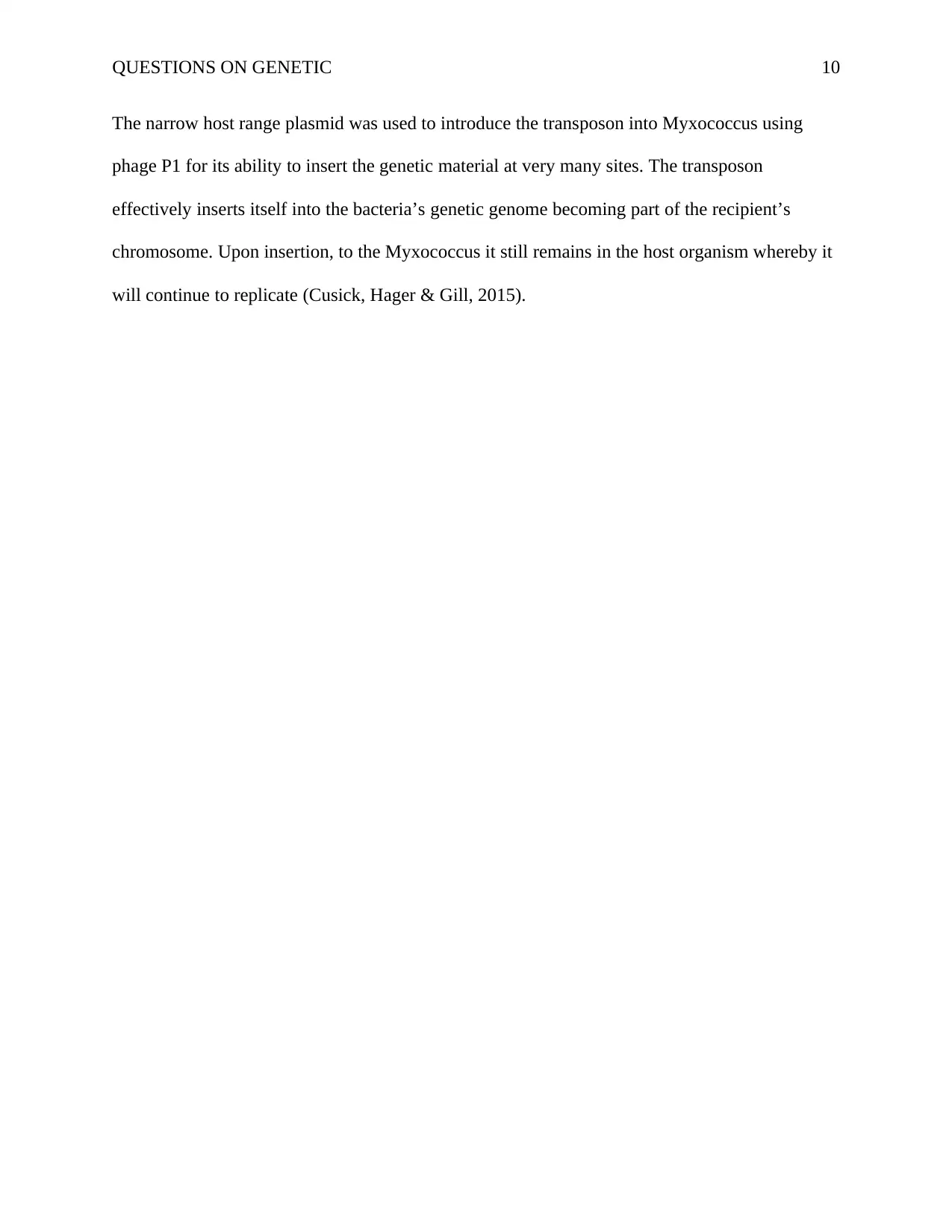
QUESTIONS ON GENETIC 10
The narrow host range plasmid was used to introduce the transposon into Myxococcus using
phage P1 for its ability to insert the genetic material at very many sites. The transposon
effectively inserts itself into the bacteria’s genetic genome becoming part of the recipient’s
chromosome. Upon insertion, to the Myxococcus it still remains in the host organism whereby it
will continue to replicate (Cusick, Hager & Gill, 2015).
The narrow host range plasmid was used to introduce the transposon into Myxococcus using
phage P1 for its ability to insert the genetic material at very many sites. The transposon
effectively inserts itself into the bacteria’s genetic genome becoming part of the recipient’s
chromosome. Upon insertion, to the Myxococcus it still remains in the host organism whereby it
will continue to replicate (Cusick, Hager & Gill, 2015).
Paraphrase This Document
Need a fresh take? Get an instant paraphrase of this document with our AI Paraphraser
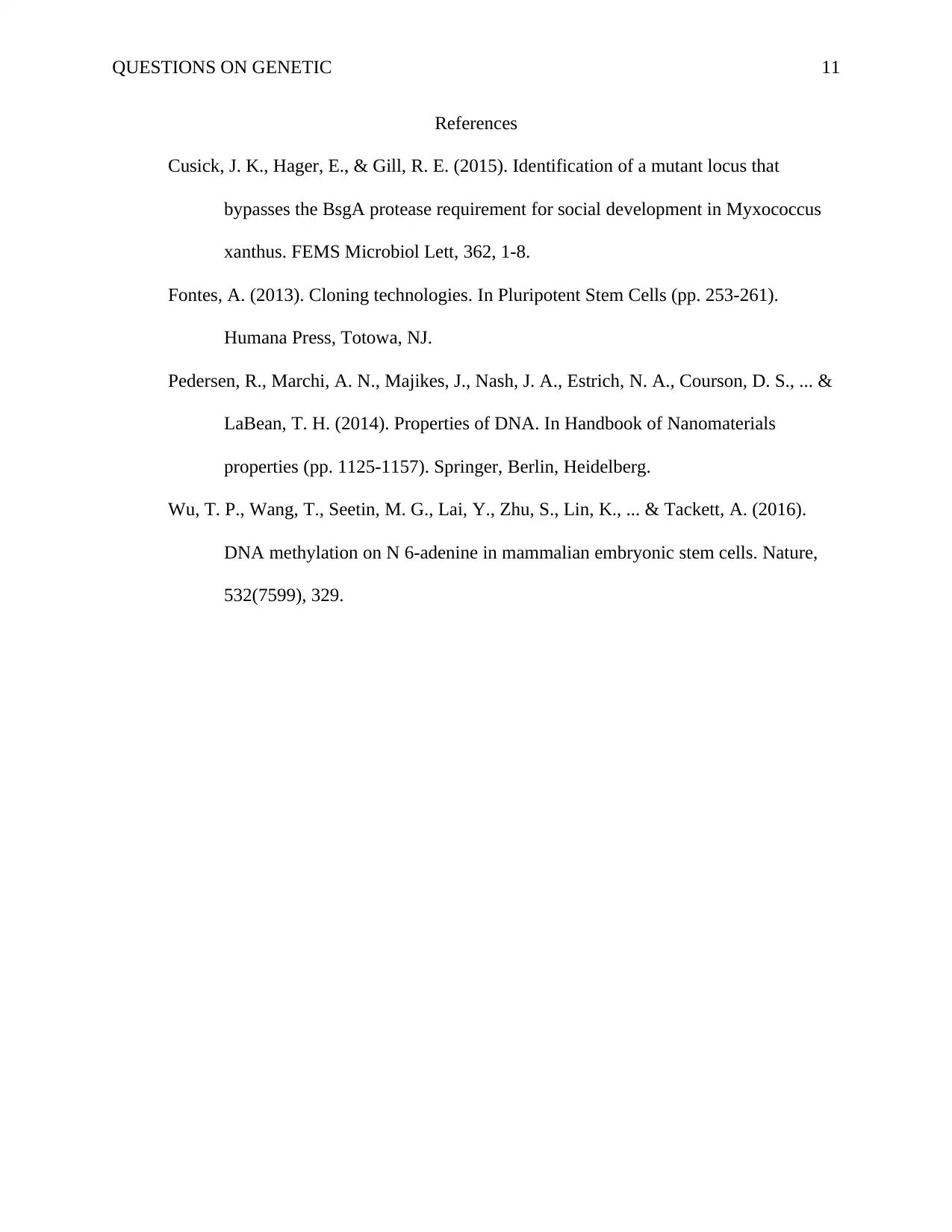
QUESTIONS ON GENETIC 11
References
Cusick, J. K., Hager, E., & Gill, R. E. (2015). Identification of a mutant locus that
bypasses the BsgA protease requirement for social development in Myxococcus
xanthus. FEMS Microbiol Lett, 362, 1-8.
Fontes, A. (2013). Cloning technologies. In Pluripotent Stem Cells (pp. 253-261).
Humana Press, Totowa, NJ.
Pedersen, R., Marchi, A. N., Majikes, J., Nash, J. A., Estrich, N. A., Courson, D. S., ... &
LaBean, T. H. (2014). Properties of DNA. In Handbook of Nanomaterials
properties (pp. 1125-1157). Springer, Berlin, Heidelberg.
Wu, T. P., Wang, T., Seetin, M. G., Lai, Y., Zhu, S., Lin, K., ... & Tackett, A. (2016).
DNA methylation on N 6-adenine in mammalian embryonic stem cells. Nature,
532(7599), 329.
References
Cusick, J. K., Hager, E., & Gill, R. E. (2015). Identification of a mutant locus that
bypasses the BsgA protease requirement for social development in Myxococcus
xanthus. FEMS Microbiol Lett, 362, 1-8.
Fontes, A. (2013). Cloning technologies. In Pluripotent Stem Cells (pp. 253-261).
Humana Press, Totowa, NJ.
Pedersen, R., Marchi, A. N., Majikes, J., Nash, J. A., Estrich, N. A., Courson, D. S., ... &
LaBean, T. H. (2014). Properties of DNA. In Handbook of Nanomaterials
properties (pp. 1125-1157). Springer, Berlin, Heidelberg.
Wu, T. P., Wang, T., Seetin, M. G., Lai, Y., Zhu, S., Lin, K., ... & Tackett, A. (2016).
DNA methylation on N 6-adenine in mammalian embryonic stem cells. Nature,
532(7599), 329.
1 out of 11
Your All-in-One AI-Powered Toolkit for Academic Success.
+13062052269
info@desklib.com
Available 24*7 on WhatsApp / Email
![[object Object]](/_next/static/media/star-bottom.7253800d.svg)
Unlock your academic potential
Copyright © 2020–2025 A2Z Services. All Rights Reserved. Developed and managed by ZUCOL.
